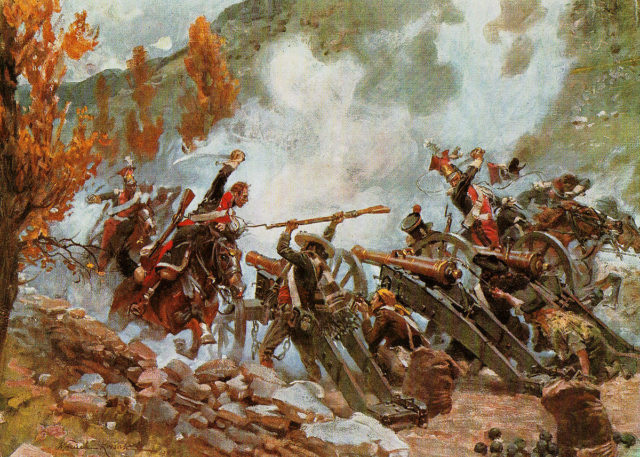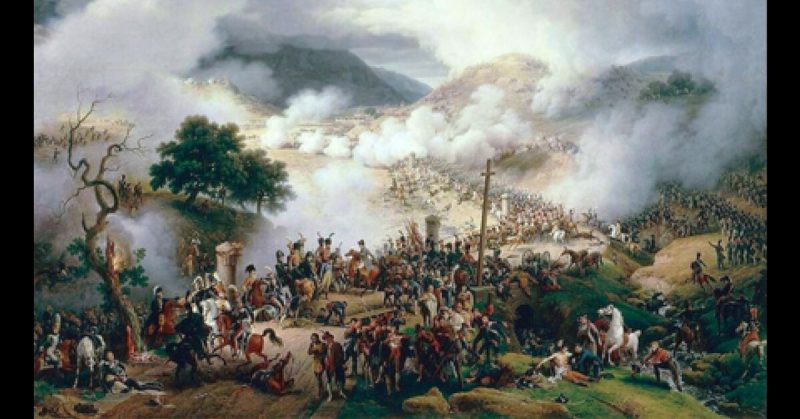The war for the Spanish Peninsula in 1807-14, was as draining to Napoleon’s military efforts as Russia was disastrous. It featured many different styles of war, from the pitched battles most associated with Napoleon and his opponents to guerrilla attacks and amphibious landings.
Sieges
Sieges played a greater part in the Peninsular War than in any other part of the Napoleonic Wars. Centuries of warfare and military engineering had left Spain with many strongly defended towns and fortresses. As troops advanced across the Peninsula, they were compelled to take them or leave enemy forces at their rear.
Such was the importance and frequency of siege warfare that Lieutenant Colonel John T. Jones, a British engineer, calculated the number of soldiers needed to besiege a garrison of a particular size. Depending upon circumstances, Jones’s calculations showed that between five and eight times as many attackers as defenders were needed to ensure capture. Although figures from real sieges reveal that Jones’s calculations were not entirely accurate, they show the importance and scale of those fights.
The size is also reflected in the enormous amount of artillery ammunition used by the British in besieging French positions; 70,563 rounds in the siege of San Sebastian alone.
Harassing Shipping
By the time the British arrived in the Peninsula, the Royal Navy had already achieved dominance at sea. Victory at Trafalgar in 1805 had cost the British their greatest admiral in the form of Nelson. It had also left them with no effective opposition in the seas off Spain. The French made no attempt to challenge them as part of the Peninsular War.
The British Navy had three tasks in the war. The safe transportation of men and supplies; landing amphibious attacks; and harassing enemy shipping.
As they had done for centuries, British crews took to the essentially piratical action with great success. Coastal traffic, the fastest and most efficient way to transport goods around much of Spain, was disrupted by British raiders. French ships, threatened with superior British forces if they set out to sea, were often compelled to surrender, as happened at Cadiz in June 1808.
Guerrilla Warfare
The word “guerrilla” came into the English language during that time. The Spanish for “little war,” it described a form of irregular warfare that had not previously been seen as important in Europe. It proved vital in the Peninsula.
Thousands of Spaniards under dozens of different leaders fought against French occupation. Men with nicknames such as Manco (“one hand”), El Empecinado (“the obstinate”), and El Pastor (“the shepherd”) led attacks against the French, both on their own and in coordination with regular forces.
There was not a clear distinction between guerrilla and regular forces. Some of the early groups were trained soldiers from dispersed units, such as those led by Juan Diaz Porlier, El Marquesito. As British, Portuguese, and patriotic Spanish troops advanced, guerrilla groups found themselves no longer behind French lines. At that point, many joined the regular army, contributing to both the infantry and cavalry.

The guerrillas were very effective. They killed soldiers, disrupted supply lines, and distracted troops from other tasks. Their presence and the difficulty of pinning them down undermined French morale.
They could also be incredibly brutal, due to their ill-feeling against the invaders. It led to atrocities and counter-atrocities on both sides, including the murder of prisoners and civilians.
Pitched Battles
From Medina de Rio Seco on July 14, 1808, to Bayonne on April 14, 1814, the Peninsula War fought more than 25 battles of significant size. 14,000 men were engaged at Bayonne but ten times that number fought at Vittoria on June 21, 1813.
Pitched battles in the Napoleonic era involved a combination of infantry, cavalry, and artillery. Infantry was by far the largest part of an army. Massed ranks of men fired immense volleys of muskets, with devastating effect. The limited range of both guns and artillery meant battles were fought at relatively close quarters. Gunfire was followed by fighting with bayonets. For all the glamor that mounted charges held, the main role of cavalry was to harass the wings and pursue fleeing enemies.
Both sides had their battlefield successes, but the Allies had a significant advantage. The leading French general of the era, Napoleon, was usually busy elsewhere in Europe. The foremost British commander, on the other hand, was leading the Allies in the Peninsula. Sir Arthur Wellesley’s success by the end of the campaign had earned him titles among the aristocracy of three countries; most famously as the Duke of Wellington.
Battlefield casualty rates ranged from 0.5% among Wellesley’s troops at Oporto (May 12, 1809) to nearly 42% under Cuesta at Medellin (March 29, 1809). On average, around 14% of the casualties were killed and more died of their wounds later.
Some battles were little more than tests of strength or fighting retreats. Others saw large armies crippled, turning the course of the war.
Amphibious Landings
Using their dominance of the seas, the British landed troops from ships and launched coastal raids by marines all over occupied Spain.
An expert in Britain’s use of amphibious warfare was Captain Home Riggs Popham. Before the Peninsula War, Popham had not always bathed in glory. He planned a disastrous raid on Ostend in 1798 and launched an unauthorized expedition to South America in 1806.
Despite his failures, Popham was set loose in the Spanish Peninsula. There, the importance of coastal positions enabled him to launch a string of successful raids from mid-1812. The diversionary attacks were Wellington’s idea, but their success was down to Popham, who oversaw collaboration between seamen, marines, and guerrillas. They diverted French troops from other duties and captured Santander, a strategically significant victory because it shortened the British supply line.
Source:
Philip Haythornthwaite (2004), The Peninsular War: The Complete Companion to the Iberian Campaigns 1807-14
